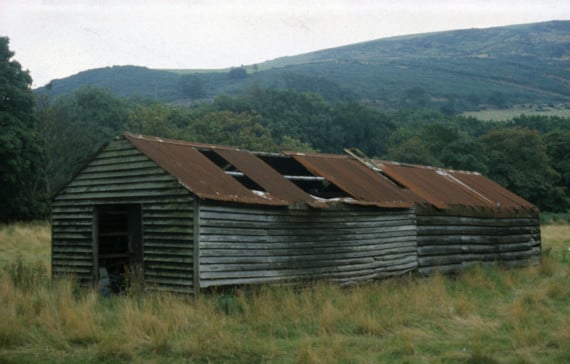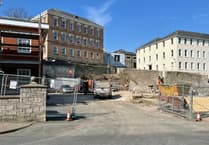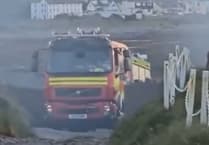Buildings at Risk looks at buildings and structures at risk, lost and saved.
In this edition, Dave Martin of the Isle of Man Natural History and Antiquarian Society looks at the development of woollen mills on the island - some now lost, some saved, and some still at risk.
Wool was one of the first fibres to be spun and then woven to make fabric for clothing.
At first, this was a home activity or cottage industry, but gradually became more centralised and industrialised.
Because of the modest buildings they used - sometimes even with just mud walls - the homes and weaving sheds of handloom weavers are almost all gone but substantial evidence still remains of some of the more industrialised woollen mills which reached their peak in the late 19th and early 20th centuries.
We will return to look at both handloom weavers and flax/linen mills in future editions, but this week we will look at the development of woollen mills - some now lost, some saved, and some still at risk.
It is important to recognise that woollen mills didn’t just spin and then weave wool.
The journey from fleece to fabric has a number of stages.
A newly-shorn fleece on its own is pretty fragile, only held together by the crimp of adjacent fibres, so to start its journey it is cleaned and separated into individual fibres - initially as loose random clumps and then carded to start to straighten the fibres, or at least get them parallel to each other.
Fleeces have to be cleaned of dirt and earth and grass etc, which have been picked up whilst the fleece was serving as the sheep’s coat.
Also, especially if the wool is to be dyed, the lanoline - a grease which protects and waterproofs the fleece - must be removed. One de-greasing agent used was potash made by burning dried bracken.
The bundles (rovings) are then spun and woven. The material is then brushed to raising the nap and then sheared to give a uniform height to the nap. Finally the cloth was washed and stretched to dry on tenter frames.
All of these processes were initially all done by hand - from ’teasing’ the fleece apart, using teasel heads or bats with beds of nails, to the oft-pictured spinning on a hand-wheel, to dying the wool in the kitchen, to hand/foot powered looms.
However, some processes were out-sourced or centralised quicker than others.
Processes where a hand-worker could add distinctive value, such as the weaving, or processes such as spinning where work could be done at home and fitted around other chores, were some of the last to be centralised and industrialised.
To start with, processes which could benefit from non-human power were some of the first to be industrialised, and carding mills appeared on some of the island’s rivers.
These had waterwheel-powered machines to card (comb) the fleece.
Some of these extended their services by including the cleaning of the fleece and roving, and once mechanised ’mule’ and ’jenny’ spinning machines were introduced. They offered spinning as well.
Often, these mills operated on the basis that they would take one or more fleeces and return the spun woollen yarn from what you were told were your own fleeces.
Later some became more conventional manufacturers and would buy fleeces and sell the yarn.
’Cooking up’ basic organic dyes is millennia old, using natural materials.
Local sources included woad (blue), madder (red/pink), weld (yellow), lichens (various colours), chestnuts (brown). This was later augmented by imported dyestuffs such as indigo and logwood (blue) or cochineal (red).
After most dyes have been used, a mordant (based typically on iron salts, alum, or ammonia) is used to fix the dye so it doesn’t wash out, similar to the use of a fixer after a photographic print is newly developed.
Fixing with a mordant also facilitates re-dying in a different dyestuff, so the sequence woad/mordant/weld/mordant will give green, or woad/mordant/madder(or cochineal)/mordant which gives purple.
Mordants can also affect the resultant colour, tin- and chrome-based mordants brighten colours, whereas iron-based mordants make them duller.
Logwood on its own gives a pale or muddy blue, but when followed by iron sulphate mordant, sombre blacks can be achieved - this was much exploited in Victorian times.
If a garment was all one colour, it could be ’piece-dyed’ after it was woven, but if there were different colours in the pattern, it had to dyed in the spun yarn, or as raw un-spun wool - hence the phrase ’dyed-in-the-wool’.
Dye Works to Woollen Mills
In the 19th century, while there were still reasonable numbers of hand-loom weavers across the island, one operation which was increasingly outsourced was dying.
This was driven by, among others factors, patterns needing multiple colours of yarn, issues over colour-matching between batches and the introduction of inorganic dyestuffs, such as aniline dyes derived from coal-tar in 1856, and acid dyes, from 1875.
By the 1870s, inorganic dyes became dominant for commercial work, although there was a resurgence - small in volume, but of considerable impact - in the use of natural dyes when they were championed by William Morris, founder of the Arts & Crafts movement.
Dye works themselves didn’t need water power, just a reasonable supply of clean water, although in return the effluent included spent dyestuffs, mordant rinsings etc. However, related processes such as carding and spinning did use water power.
As a result, various specialist trades and their works involved in processing wool tended to grow and cluster around rivers. Initially, they operated as discrete businesses - carding mills, dye works, spinning mills etc. - but over time some entrepreneurial owners expanded their range of services (what nowadays would probably be called ’vertical integration’) into what became known as ’woollen mills’.
It should be noted though that there can be superficial confusion on early maps where "W. Mill" could refer to a water mill or a woollen mill.
Woollen mills extended their service further, using water power when available, to operate mechanised looms, often in roof-lit work rooms (such as those at Tynwald Mills).
Not all wool processing was carried out in substantial mill buildings though, in fact some wasn’t in any building at all.
After the cloth was woven in the mill would be hung to dry after ’fulling’.
Drying was usually carried out in the open with the cloth hung on ’tenter frames’, such as those once seen at Tynwald Mills - wooden frames with lines of hooked-nails on which the cloth was stretched to dry under tension (hence the phrase ’on tenterhooks’).
The Manx climate meant though that outdoor drying was not always possible, and at some woollen mills, drying or tenter frames were covered and partially enclosed.
Such drying sheds, placed to catch the wind, also catch the weather as well; some were later used as field shelters but their light and airy construction left them vulnerable if not cared for.
One, un-loved and definitely at risk (the only Manx example remaining?) still exists in a field on the Tholt y Will Road on the up-valley side of the former Southward’s woollen mill at the top end of Old Sulby Village.
Built of timber with louvered sides to allow the wind to blow through, its corrugated iron roof has gaping holes and one corner looks ready to collapse.
Woollen mills on the island never reached the scale of, or were mass-mechanised, like some in Britain.
This was primarily as a result of the size of the market - although some Manx wool and woollen goods were exported.
It was also constrained by the supply of raw material (fleeces), and the mills’ use of natural power, unlike massive steam-powered mills elsewhere.
In one case though, the whole enterprise was socially motivated.
The Oxford scholar John Ruskin, born 200 years ago this year, who founded The St George’s Company in 1871 (renamed The Guild of St George in 1878) was described by Leo Tolstoy as ’one of those rare men who think with their hearts’.
Ruskin and the Guild aimed to promote the understanding and appreciation of good art, to encourage craftsmanship rather than mass production, and to revive what we should now call sustainable agriculture and horticulture.
An early supporter was Lancashire silk weaver Egbert Rydings, who became a ’Companion of St George’ in 1876 and the following year, with almost missionary zeal, established classes in Laxey - then dominated by the mining industry - to promote artisanal spinning and weaving.
In 1879, in a combination of entrepreneurship and missionary fervour, Rydings took a share in a corn mill and commenced refitting it as a woollen mill to encompass carding, spinning, weaving and dying. Fit-out, including a new water-wheel, was estimated to cost £500.
The St George’s woollen mill opened in 1881, in the premises it occupies to this day.
Rydings wrote to Ruskin: ’The business is mostly with the farmers who keep a few sheep on the mountain.
’They bring their wool to me, and either I manufacture it into cloth, flannel, blankets or any other material they want, or they give the wool to me and I give them manufactured goods in exchange for it.’
This led the late Mona Douglas to describe the process as ’From Mountain Track to Wearer’s Back’.
And now â?¦.
Many of the early carding mills and dye works have fallen victim to the ravages of time.
Proximity to their source of water-power also brings risks - Laxey Mill on Glen Road is a current case in point. The ’Great Flood’ of 1930 forced the closure of the Glen Auldyn woollen mill, and caused major damage to the Sulby woollen mill business.
However, at the Tynwald Mills, the waterwheel and mill have been sensitively restored, and the weaving and finishing sheds have made bright and airy retail premises.
The main buildings of the former Southward’s mill at Sulby, adjacent to the Tholt y Will road, have had several chapters - part is now a double-glazing workshop, whilst the weaving shed was the ’Peppermill’ restaurant and is now a thriving nursery.
Like other lucky buildings, some of the woollen mills; in the hands of caring owners, have been able to find new lives with, or without, the thread of their former purpose.



.jpeg?width=209&height=140&crop=209:145,smart&quality=75)

Comments
This article has no comments yet. Be the first to leave a comment.